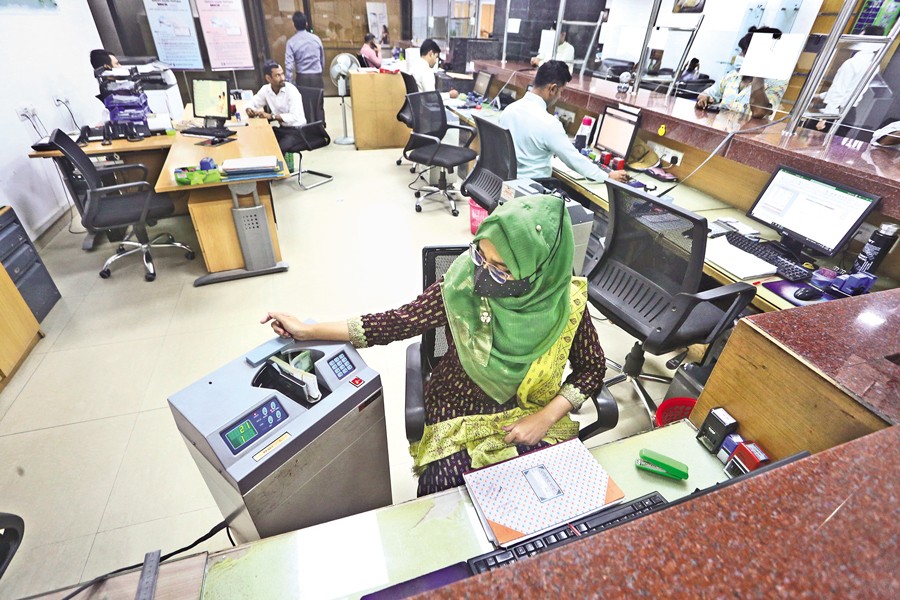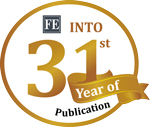M. Kabir Hassan and Mashuk Rahman | November 12, 2023 00:00:00
 A bank teller counting notes at a bank branch in Dhaka. — FE Photo
A bank teller counting notes at a bank branch in Dhaka. — FE Photo  Bangladesh's contemporary macroeconomic condition is positively trending as it continues to impress globally as one of the fastest-growing economies in the Asia-Pacific region. Since the initial shocks of the pandemic and lockdown measures a few years ago, Bangladesh has seen an expanding middle socioeconomic class, increasing domestic consumption, and vast learning and adoption of new technology among citizens and businesses. The nation has come a long way as it seeks to get out of the United Nations LDC (least-developed country) classification. Beyond ramping up several industries to meet consumer and institutional demands within Bangladesh, the nation has seen major export growth due to its readymade garment industry or RMG.
Bangladesh's contemporary macroeconomic condition is positively trending as it continues to impress globally as one of the fastest-growing economies in the Asia-Pacific region. Since the initial shocks of the pandemic and lockdown measures a few years ago, Bangladesh has seen an expanding middle socioeconomic class, increasing domestic consumption, and vast learning and adoption of new technology among citizens and businesses. The nation has come a long way as it seeks to get out of the United Nations LDC (least-developed country) classification. Beyond ramping up several industries to meet consumer and institutional demands within Bangladesh, the nation has seen major export growth due to its readymade garment industry or RMG.
However, its recent growth faces various macroeconomic hurdles that will test the nation in its pursuit to become a high-income nation. The current global inflation woes, coupled with elevated volatility conditions, have weighed in on production growth, foreign-currency reserves, and the Taka exchange rate. The drivers that fostered Bangladesh's impressive growth also point out looming issues and adjustments the nation must take to improve its economy in the near future.
Last month, the government and the Organization for Economic Co-operation and Development issued a joint report - Production Transformation Policy Review (PTPR) of Bangladesh - based on a 20-month consulting process in Dhaka. The garment industry has proved to be pivotal for Bangladesh's export economy, with twenty apparel products accounting for 84 per cent of total domestic exports. Additionally, RMG has been a significant driver for production growth, job creation, and gender inclusion. Due to current market conditions of slowed export demand and financial-sector instability, a lack of diversification in the export economy highlights that Bangladesh must improve trade-competitiveness soon.
According to the World Bank's Bangladesh Development Update April 2023, while 2022 saw a real GDP growth of 7.1 per cent, the recent estimate for 2023 is a hampered 5.2 per cent. This should, however, transcend back to 6.5% with easing inflationary pressures in future years. Following global trends, Bangladesh saw inflation soar from 6.1% to 9.5% through the first eight months of 2023. The primary observation in 2023 with macroeconomic conditions is inflation. In Bangladesh, the heightened inflation this year placed immense pressure on lower- income households notably. The cities have seen long ques with the Open Market Sales (OMS) trucks which distribute low-priced essentials. The general global outlook on inflation is favorable for 2024 due to more favorable price growth in international commodities as advanced economies faced slower growth this year.
Due to refinancing schemes within the banking sector, credit growth rose while liquidity fell due to negative real deposit rates. Thus, financial-sector vulnerabilities widened, with a rise in non-performing loans, weak capital buffers, and bank- governance challenges. Estimated public debt (excluding guarantees) rose to 33.6 per cent of GDP in 2022. The external debt accounts for a third of total debt and it is mostly owed to multilateral and bilateral creditors. The debt is traced to major infrastructure projects. Regarding Bangladesh's debt situation, the January 2023 joint World Bank-IMF Debt Sustainability Analysis (DSA) diagnosed a low risk of debt distress. Historically and currently, debt financing relies on domestic, and then, foreign borrowing. Net borrowing in the banking sector increased by 55.7 per cent, the National Savings Certificate borrowing decreased by 39.1%, and the net foreign financing increased by 54.4%. All percentages are calculated on a year-over-year basis.
The current -account deficit widened to 4.0% of GDP due to a 35.5-percent surge in imports and a 15.1-percent decline in official remittance inflows. On the positive side, resilient export growth (10% in 2023 so far) helped narrow this trade deficit. Foreign-exchange reserves declined through 2023 as Bangladesh Bank intervened to support the taka on the foreign-exchange market. A multiple exchange rate was introduced at the end of 2022, which ended up hurting the economy in 2023 due to disincentivizing exports and official remittance inflows. Instead, using a single market-clearing exchange rate would reduce the distortive consequences of the multiple, complex exchange rate.
The fiscal deficit is estimated to have widened to 4.3% of GDP as expenditure growth outpaced revenue growth.Net trade credit declined significantly with a decline in inputs and tighter trade-credit supply. Medium- and long-term borrowings decreased with rising interest rates. This resulted from both a decline in imports and a contraction in the supply of trade credits amidst tighter global credit conditions. Medium- and long-term borrowings declined over the same period as authorities sought to limit borrowing at higher interest rates.
Altogether, the balance-of-payments deficit increased from $5.3 billion to $7.2 billion in the first eight months of this year. Bangladesh's government responded with a complex exchange-rate model to relieve pressure on forex reserves in response to the widening shortage. Consequently, this had an adverse effect as tariff hikes and import controls yieled costly results in investments, exports, and GDP growth. The World Bank advises that Bangladesh minimize price-quantity controls and leans toward market-based monetary and fiscal policy. Bangladeshi banks saw low net interest margins due to lending-rate caps. However, a benchmark lending rate would beneficially push the banking sector toward utilizing policy rate-based transmissions rather than reserve-based transmissions.
The industrial sector grew by 9.9%in 2022, due mainly to manufacturing surrounding readymade garments. However, gas and electricity shortages disrupted industrial production in 2023. Additionally, restriction on issuance of letters of credit and higher input costs of oil, cement, steel, and fertilizer further exacerbated industrial-production woes in 2023. Altogether, the trajectory of growing domestic consumption in recent years saw many citizens struggle with lower purchasing power due to a constrained supply of goods and services and rising inflation. Consumer-spending growth has slowed but continues to be relatively strong. Falling real wages and declining household savings, particularly for low- and middle-income households, further support that consumption-spending growth should stay steady in the short-term future.
Bangladesh has been notable for its microfinance initiatives and poverty reduction over the last decade. Of deserving praise, the rural areas have seen an increased standard of living and technological adoption. On the contrary, urban areas still face massive wealth and gender inequalities. Pandemic job losses and reduced earnings disproportionately affected the poor, especially females. While employment levels saw an uptick in 2022, real earnings did not meet proportional standards in growth - also failing to reach pre-pandemic levels.
One diversification direction of Bangladesh has seen the steady maturing of domestic industries focused on electronics and electrical production and pharmaceutical manufacturing. Currently, these industries meet 98 per cent of the domestic consumption. However, this consumption will grow, and the production capabilities must follow suit. We have seen Bangladesh accelerate in terms of digital adoption and availability of the web. 4G broadband connection is available for 94% of the region. However, the infrastructure still needs improvements as metrics such as internet speed and digital use in education require necessary improvement.
In 2018, the government issued the Active Pharmaceutical Ingredients (API) and Reagents Production and Export Policy. The initiative aims to reduce import reliance, diversify export potential, and keep drug prices affordable to citizens. While this industry is relatively young (accounting for 1% of Bangladesh exports in 2022), it is rapidly growing in production, foreign investment, and multi-national partnerships. Furthermore, the policy offers financing incentives and tax breaks for API manufacturers in Bangladesh. Firms manufacturing five or more API molecules per year will continue to pay no tax until 2032, and those with at least three are awarded a 75% exemption until 2032. Additionally, the government is investing in manufacturing, office, and laboratory space construction for the pharmaceutical industry.
On another positive note, Bangladesh's government has been investing and constructing infrastructure in the country. Capital-expenditure growth accelerated in 2022 with project -implementation acceleration and fewer pandemic-related restrictions and assistance. While the country has struggled to recuperate much of the spending here with challenges in revenue collection and budget collection - which explains the capital-accounts deficit - the 2023 budget still concentrates on large infrastructure projects. The deficit is further exacerbated by current market conditions. However, Bangladesh is taking the right action to improve roads, transportation, and buildings. Investments must accommodate increased consumer demand, production growth, industrial diversification, travel and tourism, and climate change-related adjustments. Most notably, the 2022 completion of the Padma Bridge can spur new investments and boost regional production in the Khulna and Barishal regions. The new rail system in Dhaka should also foster growth in the metropolis.
Given the trajectory of global trade and macroeconomic conditions in the last few years, Bangladesh has done well to focus investment on domestic industries which make it a notable player in international business while enhancing many socioeconomic aspects within its borders. With increased consumer demand, Bangladesh saw significant growth in its textile industries. Simultaneously, it has been investing in poverty-reduction recipies and various credit channels. With the global inflationary and volatility obstacles this past year, Bangladesh has seen faults in its current export market, labour market, and banking sector as it has further hampered its growth from last year.
Bangladesh must continue diversifying its production structure and export economy. It must continue to incentivize growth in the electronics and pharmaceutical industries. As the government bestows tax benefits to growing and new industries, it should monitor innovation, foreign direct investment, education, and employment metrics. Gradually, these markets should become more competitive and then cyclically foster positive output and metrics for years to come. At the same time, Bangladesh should invest in sustainable and/or environmentally conscious infrastructure, education, and global marketing to combat future fluctuations in global markets and climate change.
Bangladesh would benefit from an updated domestic policy approach to comply with international trade regulations. First, the country should move toward adopting a single rate for similar goods irrespective of origin. Second, it should look at updating the current primary export goods (garments) and removing inefficiencies, particularly by way of reducing transaction costs. Third, it should investigate utilizing key service inputs and incorporating digital features. Fourth, Bangladesh should examine existing and potential trade-liberalization options and then maximize returns unilaterally within these options.
Socioeconomically, Bangladesh should continue its development efforts to foster more skilled work acumen and effective business dialogue with investment in education. Altogether, it should bridge existing gaps in digital utilization, gender opportunity, and wealth inequality. Furthermore, Bangladesh must enforce policy to advocate for responsible business conduct and ethical and green infrastructure development. Ultimately, Bangladesh should shift its economic and banking policies to become more market-based and move its business policies to be innovation-driven.
M. Kabir Hassan is a professor of Finance at the University of New Orleans, USA. mhassan@uno.edu
Mashuk Rahman is a Ph.D. student at the University of New Orleans, USA
© 2025 - All Rights with The Financial Express
